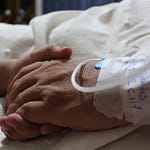A very common denial that insurance companies will do is called a “DRG” denial. “DRG” stands for “Diagnostic Related Group.” According to the Center for Medicare and Medicaid Services (CMS), DRGs are “a patient classification scheme which provides a means of relating the type of patients a hospital treats (i.e., its case mix) to the costs incurred by the hospital.” It is how CMS - and some commercial insurance companies - determines how much to pay for a hospital stay.
A DRG has a “principal diagnosis,” or the main reason for the hospital stay, and then any number of “secondary diagnoses,” or other conditions that were present in the patient during the hospital stay. A very common DRG denial I see is one where the commercial insurance company will deny “acute respiratory failure.” The reason they do this is because acute respiratory failure greatly increases the severity of illness of a hospital stay, and thus the payment that insurance company has to make. Eliminate “acute respiratory failure,” and the severity of illness goes down, and then so does the payment.
The DRG denials I see are those where the insurance company pays for a hospital stay, and then they do a “post-payment audit” and tell the hospital, “We performed an audit, and we realized that we overpaid you. This is because there really wasn’t ‘acute respiratory failure’ during this stay. Thus, you owe us $5000.” Then they lay out the reason why they are denying that diagnosis in the rationale.
A very common rationale for denying “acute respiratory failure” is based on an an article such as this one from “The Hospitalist”:
One needs to have two of the following three criteria to make a formal diagnosis of acute respiratory failure:
pO2 less than 60 mm Hg (hypoxemia).
pCO2 greater than 50 mm Hg (hypercapnia) with pH less than 7.35.
Signs and symptoms of acute respiratory distress.
With all due respect, as a Pulmonologist, I disagree with this.
In its essence, acute respiratory failure is a failure of gas exchange. When the lungs cannot adequately oxygenate or ventilate (for whatever myriad reasons), the patient has acute respiratory failure. Yes, you need low oxygen levels (pO2 less than 60 or oxygen saturation less than 90%) and/or elevated carbon dioxide levels with respiratory acidosis (as noted in the above article) to diagnose hypoxia or hypercapnia. But that is it.
Signs and symptoms of respiratory distress are a consequence of the primary failure of pulmonary gas exchange, and do not necessarily need to be present. For example, I have seen many patients with COVID-19 who had absolutely no respiratory distress at all, but they had oxygen saturations in the 50s. Clearly, this is acute hypoxemic respiratory failure. And, I have seen comatose patients with severe hypercapnic respiratory failure, again with absolutely no respiratory distress. This is clearly acute hypercapnic respiratory failure.
The other essential component of adequate pulmonary gas exchange is airway patency. Having normal upper airway reflexes, and no obstruction to airflow, is absolutely necessary to allow for adequate pulmonary gas exchange. If someone chokes on a piece of steak, for example, that can quickly lead to acute respiratory failure. In addition, if someone is comatose - from a drug overdose, for example - and cannot maintain a patent airway due to the loss of normal upper airway reflexes, this also leads to acute respiratory failure.
Now, we clinicians will frequently document in the record that a patient was intubated for “airway protection,” and the insurance company will seize on this phrase and say “there is no such diagnosis as ‘airway protection.’’ In fact, I saw an insurance company deny the diagnosis of acute respiratory failure in a teenager who suffered cardiac arrest at home and had to be placed on a ventilator. The reason for the denial? There is no diagnosis called “airway protection.”
While this is technically correct, it is nevertheless very disingenuous. Therefore, I never write “airway protection” in the record of a patient who was intubated due to being comatose from an acute opioid overdose, for example. I write the following:
“Acute respiratory failure secondary to the failure to maintain a patent airway due to toxic metabolic encephalopathy from an acute opioid overdose.”
Yes, it is a mouthful, but it does not give an insurance company a route to deny the diagnosis of “acute respiratory failure.”
Now that Medicare Advantage insurance plans must follow the Two-Midnight rule, which will lead to they having to pay for many more inpatient hospital stays, expect to see many more of these DRG denials come through to your institution. When it comes to the diagnosis of “acute respiratory failure,” it is all about - and only about - airway patency and a failure of pulmonary gas exchange. Period.














From the Appeals Desk: Acute Respiratory Failure